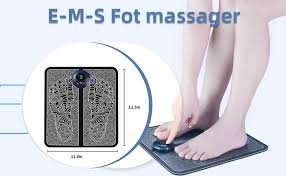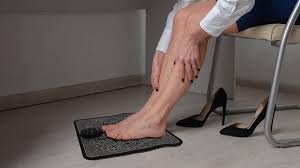How To Work EMS Foot Massager
How To Work EMS Foot Massager
If you’ve been searching for a modern solution to foot pain or poor circulation, EMS foot massagers are likely on your radar. But before using one, it’s helpful to understand exactly how to work EMS foot massager. In this article, we explain the science behind EMS technology and how it helps improve foot health and relaxation.

What Is EMS Technology?
EMS stands for electrical muscle stimulation. It involves the use of low-frequency electrical impulses to stimulate muscle contractions. Originally developed for physical therapy and muscle rehabilitation, EMS is now widely used in fitness and wellness devices, including foot massagers.
How To Work EMS Foot Massager
Electrical Impulse Transmission
The EMS foot massager has conductive pads or surfaces that come into direct contact with your skin. When you place your feet on the device and turn it on, it sends electrical impulses through the soles of your feet.
These impulses are low-voltage but enough to activate the motor nerves in your muscles, causing them to contract and relax similar to what happens during physical exercise.
Muscle Stimulation and Contraction
When the muscles receive these signals, they respond by contracting rhythmically. This mimics the natural process your muscles go through when walking or exercising, even though you’re not moving.
These contractions help:
-
Boost blood circulation
-
Reduce muscle stiffness
-
Encourage lymphatic drainage
-
Improve nerve response
Pain Relief and Endorphin Release
EMS also triggers the release of endorphins, the body’s natural painkillers. This makes the device especially helpful for those suffering from:
-
Neuropathy
-
Plantar fasciitis
-
Heel spurs
-
Leg cramps

Customizable Intensity Levels
Most EMS foot massagers allow you to choose from multiple intensity levels. This ensures that both beginners and experienced users can find a comfortable setting. As the intensity increases, the muscle contractions become more pronounced, providing a stronger massage effect.
Key Components of an EMS Foot Massager
-
Electrode Pads or Gel Pads: Conduct the electrical impulses into the feet.
-
Control Panel or Remote: Adjust intensity, modes, and timer settings.
-
Modes/Programs: Different wave patterns for varied effects (tapping, kneading, etc.).
-
Power Source: Either battery-operated or USB/electric plug-in.

EMS vs TENS: What’s the Difference?
Some foot massagers combine EMS with TENS (transcutaneous electrical nerve stimulation. While EMS targets muscles, TENS focuses on nerves to block pain signals. EMS is ideal for muscle strengthening and circulation, while TENS is more about pain management.
Now that you understand how to work EMS foot massager, it’s easy to see why it’s gaining popularity for foot therapy. By using gentle electrical impulses, these devices promote circulation, reduce pain, and stimulate muscles—all without requiring any effort on your part. It’s a smart, non-invasive way to care for your feet from the comfort of your home.
FAQs About How To EMS Foot Massager
1. What does an EMS foot massager do?
An EMS foot massager sends low-frequency electrical impulses through the soles of your feet to stimulate muscle contractions, improve circulation, relieve pain, and reduce tension.
Is EMS foot massager safe to use?
Yes, EMS foot massagers are generally safe for most people. However, they should not be used by individuals with pacemakers, epilepsy, or certain heart conditions. Always consult a healthcare provider if unsure.
Does EMS foot massage hurt?
No, EMS foot massage should not hurt. You may feel tingling or pulsing sensations, which are normal. Start with the lowest intensity and gradually increase as you get used to it.
How long should I use an EMS foot massager?
Most EMS foot massagers recommend using them for 15 to 30 minutes per session, up to 2–3 times a week. Always follow your device’s manual for specific guidelines.
Can EMS foot massager help with neuropathy or diabetes?
Some people with diabetic neuropathy find relief from EMS therapy due to improved circulation and nerve stimulation. However, it’s essential to talk to your doctor before using EMS if you have any medical conditions.
What’s the difference between EMS and TENS in foot massagers?
EMS targets muscle contractions to strengthen and stimulate circulation, while TENS targets nerves to block pain signals. Some devices offer both for combined benefits.
Do EMS foot massagers really improve blood circulation?
Yes, by stimulating muscle contractions, EMS foot massagers help push blood through the lower extremities, which can improve circulation and reduce swelling or fatigue.




